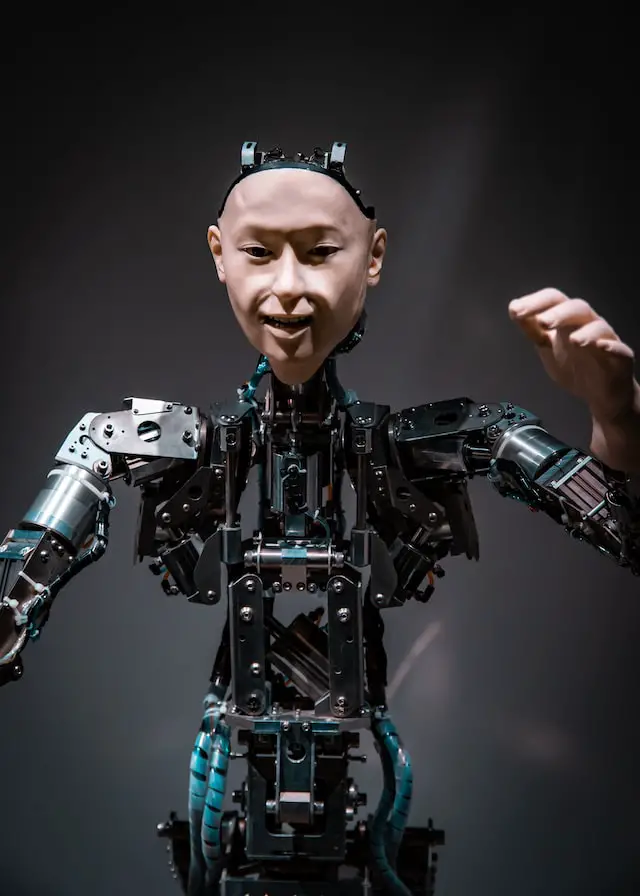Cybernetics is concerned with the control and regulation systems in biological organisms while robotics deals with developing artificial machines that can act autonomously or be controlled by a human operator. While there are some similarities between these two topics, it’s important to remember that they are distinct specialties in their own right. With advancements in technology, both of these areas have become increasingly popular and offer exciting opportunities for research and development.
What is cybernetics?
(Photo by Maximalfocus on Unsplash )

Cybernetics is an interdisciplinary field of study that combines ideas and methods from various fields such as mathematics, engineering, biology, and psychology to understand and control complex systems. The word “cybernetics” comes from the Greek word “kybernetes,” which means “steersman” or “pilot,” and refers to the control and regulation of systems.
The field of cybernetics is concerned with the study of how systems, both natural and artificial, process information, adapt to their environments, and maintain stability and control. Cybernetic systems can be found in a wide range of domains, from biological systems like the human body and ecosystems, to technological systems like computer networks, robots, and artificial intelligence.
Cybernetics is important for understanding and designing complex systems, as well as for addressing issues related to communication, control, and regulation. The principles of cybernetics have been applied to many fields, including biology, psychology, engineering, economics, and management, among others.
What is robotics?
(Photo by Alex Knight on Unsplash )

Robotics is a field of study that deals with the design, construction, operation, and application of robots. A robot is a machine or device that can be programmed to perform a variety of tasks, either autonomously or with human guidance. Robotics draws on a variety of disciplines, including computer science, engineering, physics, and mathematics.
Robotics technology has advanced rapidly in recent years, leading to the development of a wide range of robots that can perform different types of tasks. These include industrial robots used in manufacturing, medical robots used in surgery, and military robots used in surveillance and combat.
The study of robotics involves understanding the mechanics of robotic systems, as well as the algorithms and software that control them. It also involves exploring new applications for robotics, such as in space exploration, disaster response, and agriculture.
Overall, robotics has the potential to transform a wide range of industries, making tasks faster, safer, and more efficient. Robotics is an exciting and rapidly evolving field, with many opportunities for innovation and discovery.
The difference between cybernetics and robotics
Cybernetics is the study of control and communication in animals and machines. Robotics is the branch of engineering that deals with the design, construction, and operation of robots.
In simple terms, robotics is the branch of technology that deals with the design, construction, and operation of robots. Cybernetics, on the other hand, is a much broader field that covers any kind of self-regulating system, whether it is natural or man-made.
While both cybernetics and robotics are concerned with systems that can control and/or adapt to their environment, robotics focuses specifically on physical systems. This includes everything from industrial robots to humanoids to nanorobots. Cybernetics, on the other hand, can encompass non-physical systems as well; for example, economic or social systems.
There is a lot of overlap between the two fields, and many researchers work in both cybernetics and robotics. However, they tend to focus on different aspects; cyberneticians are more interested in understanding how systems work, while roboticists are more interested in designing and building systems that can carry out specific tasks.
The two fields are similar in that they both deal with the control and communication of systems. However, cybernetics focuses on biological systems, while robotics focuses on artificial systems. Cybernetics is concerned with how living organisms process information and how they use feedback to control their behavior. Robotics, on the other hand, deals with the design and operation of robots, which are artificial devices that can be used to perform tasks or simulate human behavior.
Applications of cybernetics and robotics
Cybernetics and robotics are both interdisciplinary fields of study that focus on the design and application of systems that incorporate feedback mechanisms to control and optimize performance. Cybernetics is concerned with the understanding of how biological, social, and technical systems interact and adapt to their environment, while robotics focuses on the design and implementation of intelligent machines that can perform tasks autonomously.
Applications of cybernetics include automatic control systems, artificial intelligence, cognitive science, machine learning, neural networks, robotic surgery, and prosthetics. Robotics applications range from industrial automation to military drones to domestic robots such as vacuum cleaners and lawn mowers. As technology advances, the boundaries between these two fields are becoming blurred as they increasingly overlap in areas such as artificial intelligence, machine learning, and neural networks.
Who is the father of cybernetics?
Norbert Wiener is considered the father of cybernetics, as he coined the term and developed the theory in the 1940s. Cybernetics is the study of systems and feedback loops, particularly in regards to how humans and machines interact. Robotics is a subset of cybernetics that deals specifically with robots and their design, development, and control.
What is the basic concept of cybernetics?
The basic concept of cybernetics is the study of how humans and machines interact. It is concerned with the ways in which humans use technology to extend or enhance their abilities, and with the ways in which machines can be made to work more efficiently. Cybernetics is also interested in feedback systems, in which information about the performance of a system is used to improve its functioning.
What do cybernetic engineers do?
Cybernetic engineers design and build machines that are controlled by computers. These machines can be used for a variety of purposes, including manufacturing, transportation, and healthcare. Cybernetic engineers work with a variety of team members, including mechanical engineers, electrical engineers, and computer scientists. They use their knowledge of physics, mathematics, and engineering to design and build these machines.
Why is cybernetics so important?
Cybernetics is so important because it helps us to understand and control complex systems. By understanding how systems work, we can learn to control them and make them work better. Cybernetics is also important because it helps us to build better machines. By understanding how cybernetic systems work, we can build machines that are more efficient and more effective.
What is the first rule of cybernetics?
In cybernetics, the first rule is that feedback is always necessary in order to maintain control. This means that if you want to change the output of a system, you need to change the input first. In contrast, robotics deals with machines that are controlled by pre-programmed instructions.
What do robotic engineers do?
Robotic engineers are responsible for the design, construction, and operation of robots. They may also be involved in the development of new applications for robots. In some cases, robotic engineers may also be involved in the manufacturing of robots.
What is the basic concept of robotics?
Robotics is the interdisciplinary branch of engineering and science that deals with the design, construction, operation, and application of robots, as well as computer systems for their control, sensory feedback, and information processing. These technologies deal with automated machines that can take the place of humans in dangerous environments or manufacturing processes, or resemble humans in appearance, behavior, and/or cognition.
Much of the research in robotics focuses on creating robots that are capable of intelligent behavior. In order for a robot to be considered intelligent, it must be able to perform tasks that are typically done by humans, such as understanding natural language and recognizing objects. Additionally, intelligent robots must be able to learn from their experiences and adapt to new situations. Some of the AI methods that have been used in robotics research include neural networks, genetic algorithms, fuzzy logic systems, and evolutionary computation.
What is the difference between cybernetics and bionics?
Cybernetics is the study of control systems, while bionics is the study of living systems. Both disciplines seek to understand how systems work and how they can be controlled or manipulated. Cyberneticists typically use a reductionist approach, breaking down complex systems into their component parts in order to understand how they work. Bionicists, on the other hand, take an holistic approach, studying how living systems function as a whole.
The two disciplines also differ in their focus. Cybernetics is concerned with artificial systems, while bionics focuses on natural ones. Cyberneticists may build machines that mimic or replicate the workings of the human body, while bionicists seek to understand how living organisms work so that they can be replicated or enhanced.
So, in short, cybernetics is the study of control systems (usually artificially created) while bionics is the study of living systems (natural).
Are AI and cybernetics the same?
AI (Artificial Intelligence) and cybernetics are related fields, but they are not the same thing. Both AI and cybernetics deal with the study of complex systems, but they approach the subject from different angles.
AI is a field of study focused on creating machines or computer programs that can perform tasks that would typically require human intelligence to complete. AI systems use algorithms and statistical models to process information and learn from data, and they can be used to perform a wide range of tasks, from speech recognition to decision-making.
Cybernetics, on the other hand, is a broader field that deals with the study of how systems are controlled and regulated. Cybernetics focuses on the feedback loops and control mechanisms that are used to regulate systems, whether those systems are biological, mechanical, or technological. Cybernetics is concerned with the interaction between a system and its environment and how that system can adapt and learn from feedback.
While both fields deal with the study of complex systems and use mathematical and computational models to understand and control those systems, AI is more focused on the creation of intelligent machines, while cybernetics is concerned with the principles of control and regulation that underlie complex systems.
Featured Image By – Photo by Possessed Photography on Unsplash









